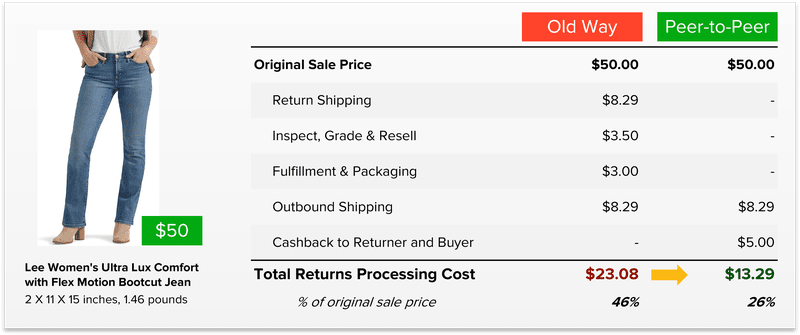Sustainable Returns: Eco-Friendly Strategies for Ecommerce Stores

Last updated on April 25, 2025

In this article
 10 minutes
10 minutes
As the world increasingly prioritizes environmental sustainability, ecommerce businesses are under growing pressure to reduce their environmental footprint. While online shopping offers convenience, it also comes with a significant environmental impact, especially in the ecommerce returns process. Returns are inevitable in ecommerce, but the way businesses manage them can make a huge difference. In fact, adopting sustainable returns practices is no longer just a nice-to-have; it’s a must-have for companies looking to build long-term loyalty, reduce carbon emissions, and meet the demands of environmentally conscious consumers. Additionally, integrating corporate social responsibility into business practices is a necessary part of meeting consumer expectations and encouraging brand loyalty.
In this article, we’ll explore how ecommerce businesses can implement sustainable returns strategies to reduce their carbon footprint, cut costs, and create a more sustainable future for their operations. Whether you’re looking to optimize your reverse logistics, reduce packaging waste, or improve your returns management system, we’ll guide you through actionable steps to implement eco-friendly solutions that benefit both the environment and your bottom line.
The Environmental Impact of Returns in Ecommerce
The retail industry has seen tremendous growth, particularly in ecommerce, where online purchases are now a major part of the market. However, this growth comes with a hidden cost: returns, which pose a significant financial burden on brands. In 2024, U.S. returns in retail totaled nearly $900 billion, with the fashion industry alone contributing to a substantial portion of those returns. While returns are an integral part of the ecommerce returns process, they also contribute significantly to carbon emissions due to transportation (shipping). In fact, the carbon footprint of processing returns, including shipping, packaging, and restocking, is estimated to be around 15 million metric tons of CO2 annually. And the significant costs associated with returns extend beyond financial implications, impacting both profitability and environmental sustainability.
The environmental costs don’t stop at transportation. Many returned items are either disposed of or end up in landfill waste, especially when they can’t be resold or refurbished. Unsold items often get sent back to warehouses where they are either recycled, discarded, or thrown away, adding to the growing issue of packaging waste.
The Need for Sustainable Returns Practices
As ecommerce businesses face increasing scrutiny from both consumers and environmental groups, adopting sustainable practices for managing returns with a focus on cost management becomes a critical step. The good news is that implementing eco-friendly returns solutions not only reduces environmental impact but can also result in significant cost savings and increased customer satisfaction. However, it’s important not to forget that minimizing returns altogether goes a long way towards long-term customer retention.
Consumer Expectations for Sustainability
Environmentally conscious consumers are more discerning about the brands they support. According to recent studies, conscious consumers are willing to pay more for products and services from brands that prioritize environmental sustainability. Brands that align their sustainability efforts with consumer values, like offering free return shipping, eco-friendly packaging, and transparent returns policies, are better positioned to enhance customer satisfaction, retain loyal customers, and build lasting relationships. Addressing environmental concerns can also lead to increased customer affinity for your brand.
Key Strategies for Implementing Sustainable Returns
There are some key sustainable returns strategies that online retailers can adopt to improve the returns process while minimizing their environmental impact. By offering instant store credit and various exchange options, for example, retailers can incentivize customer exchanges instead of refunds, which reduces returns and improves average order value. Let’s look at several strategies that can boost sales and improve overall business performance:
1. Offering Store Credit Instead of Refunds
One effective way to reduce the environmental impact of returns and achieve potential cost savings is by offering store credit instead of cash refunds. This not only keeps the returned items in circulation but also encourages future purchases and builds customer loyalty. When a customer chooses store credit, the returns management system can process the return without the need for excessive transportation or the risk of sending the product to landfill waste.
Why it works:
Offering store credit promotes sustainable consumption by encouraging customers to purchase again. This reduces unnecessary returns shipping and helps businesses optimize their inventory management. Plus, customers appreciate the flexibility of store credit, making them more likely to shop again.
2. Streamlining Reverse Logistics
Reverse logistics involves the management of product returns from the customer back to the business. Optimizing reverse logistics operations and enhancing return management are necessary for reducing the carbon emissions associated with returns. By consolidating returns into regional hubs or offering drop-off points, businesses can minimize long-distance shipping and transportation-related emissions. Furthermore, using more efficient transportation routes can help reduce transportation costs and improve operational efficiency.
Why it works:
Optimizing the reverse logistics process helps reduce waste and unnecessary emissions. Businesses that integrate returns management software with their supply chain management systems can track returns in real time, making the process more efficient and eco-friendly. Additionally, offering regional drop-off points can decrease the distance products travel, reducing fuel consumption and carbon emissions. And peer-to-peer returns, where customers forward their returns to the next purchasing customer rather than back to a warehouse, reduce the environmental impact of returns more than any other solution. Bottom line: Optimized supply chains are essential for achieving eco-friendly results, from raw material acquisition to final delivery, ensuring transparency and traceability throughout the process.
Pro Tip: Consider partnering with sustainable shipping companies that use eco-friendly methods, such as electric vehicles or carbon-neutral shipping.
3. Using Eco-Friendly Packaging
Packaging is a major source of waste in the returns process. Using eco-friendly packaging options, such as recyclable or biodegradable materials, can significantly reduce the environmental footprint of returns by reducing landfill waste. This includes using reusable packaging that can be sent back with returned items, which not only cuts down on waste but also promotes sustainable behavior among customers.
Why it works:
Switching to sustainable packaging reduces the amount of packaging waste generated by the returns process. Reusable packaging helps ensure that returned products are shipped back without additional waste, and customers will appreciate the brand’s commitment to eco-friendly packaging.
Pro Tip: Invest in sustainable packaging that’s both practical and recyclable. Avoid using materials that contribute to landfill waste and instead opt for recycled paper or biodegradable bags.
4. Leveraging Data Analytics to Reduce Returns
One of the most powerful tools ecommerce businesses have at their disposal to reduce returns is data analytics. By analyzing returns data and sustainability metrics, businesses can identify trends and root causes behind returns, such as incorrect sizing, product quality issues, or shipping problems. This information can help businesses adjust their inventory management strategies and improve product offerings to reduce unnecessary returns. Additionally, data analytics can help in improving customer satisfaction by addressing product issues before they lead to returns, unburdening the returns process.
Why it works:
With insights from data analytics, businesses can minimize returns by offering more accurate sizing guides, improving product descriptions, or addressing quality issues before they become problems. By reducing the volume of returns, businesses lower the transportation-related emissions and packaging waste associated with those returns.
Pro Tip: Use returns management software to track reasons for returns, providing insights that can help optimize your returns process and improve overall business operations.
5. Encouraging the Circular Economy
The circular economy model focuses on keeping products in circulation for as long as possible, reducing the need for new products to be manufactured, and minimizing landfill waste. Ecommerce stores can integrate the circular economy approach into their returns process by adopting sustainable return practices such as refurbishing or reselling returned items. For example, fashion retailers can partner with secondhand or resale platforms to sell gently used products, reducing waste and promoting sustainability. Adopting such practices help businesses establish themselves as sustainable brands, taking their environmental responsibility seriously.
Why it works:
By adopting a circular economy model, businesses can reduce the environmental impact of returns by keeping products out of landfills and reintroducing them into the marketplace. This not only reduces waste but also creates potential resale value, offering an additional revenue stream.
Pro Tip: Set up a secondhand program or partner with existing platforms to resell returned items at a discount, making products available to a new group of customers.
Real-Life Examples of Sustainable Returns in Ecommerce
Patagonia
Patagonia has long been a leader in sustainability. Their Worn Wear program encourages customers to return used items for repair, reuse, or resale, which significantly reduces waste. This approach aligns with their circular economy principles, helping minimize the environmental impact of returns.
IKEA
IKEA focuses on reverse logistics and eco-friendly packaging for returns, ensuring that products are sent back through the most efficient and environmentally friendly processes possible. Their commitment to sustainability extends to their returns process, making it easy for customers to make eco-conscious choices.
Educational and Engagement Platforms
Educational and engagement platforms can play a significant role in promoting sustainable ecommerce practices. By providing customers with information and resources about sustainable ecommerce, online retailers can educate and engage their customers about the importance of environmental responsibility and social consciousness.
Creating blog posts or social media content about sustainable ecommerce practices is an effective way to raise awareness and share valuable insights. Offering webinars or workshops on sustainable ecommerce can also help customers understand the impact of their purchasing decisions and encourage them to make more eco-friendly choices. Additionally, implementing customer loyalty programs that reward customers for participating in sustainable practices can foster a sense of community and promote long-term engagement.
Online retailers can also partner with environmental organizations or influencers to promote sustainable ecommerce practices and raise awareness about the importance of environmental responsibility. By building trust with their customers and demonstrating a commitment to sustainability, online retailers can enhance customer loyalty and retention, ultimately contributing to a more sustainable future for their business and the planet.
Conclusion: Building a More Sustainable Future with Ecommerce Returns
The sustainable returns ecommerce movement is gaining momentum, and businesses that adopt sustainable business practices are well-positioned to improve their environmental footprint while enhancing customer satisfaction. By implementing strategies like offering store credit, optimizing reverse logistics, using eco-friendly packaging, and promoting a circular economy, ecommerce stores can significantly reduce their carbon emissions and create a sustainable future for their operations.
Adopting sustainable returns practices not only benefits the planet but also improves customer retention, reduces operational costs, and strengthens your brand’s reputation as a sustainable and responsible business.
Frequently Asked Questions
How can ecommerce stores reduce the environmental impact of returns?
By offering free returns, using eco-friendly packaging, optimizing reverse logistics, and adopting circular economy practices like reselling or upcycling returned items.
What is the circular economy approach in ecommerce?
The circular economy approach focuses on reusing, recycling, and reselling returned products, thus reducing waste and extending the lifecycle of products.
Why should ecommerce businesses offer store credit for returns?
Offering store credit instead of refunds keeps customers engaged with the brand, promotes future purchases, and reduces the environmental cost of product disposal.
How can data analytics help reduce returns?
By using data analytics to track returns patterns, businesses can better understand customer preferences and optimize product offerings to reduce unnecessary returns.
What are the benefits of adopting sustainable returns practices?
Adopting sustainable returns practices can help reduce waste, lower carbon emissions, improve customer satisfaction, and increase customer loyalty.
How does free return shipping enhance customer satisfaction and loyalty?
Free return shipping plays a crucial role in enhancing customer satisfaction and loyalty. It provides customers with a hassle-free way to return products, which can significantly improve their shopping experience. While some retailers are moving away from this practice due to rising costs, many still see it as a vital component in maintaining a positive customer relationship and encouraging repeat business.

Up to 64% Lower Returns Processing Cost


